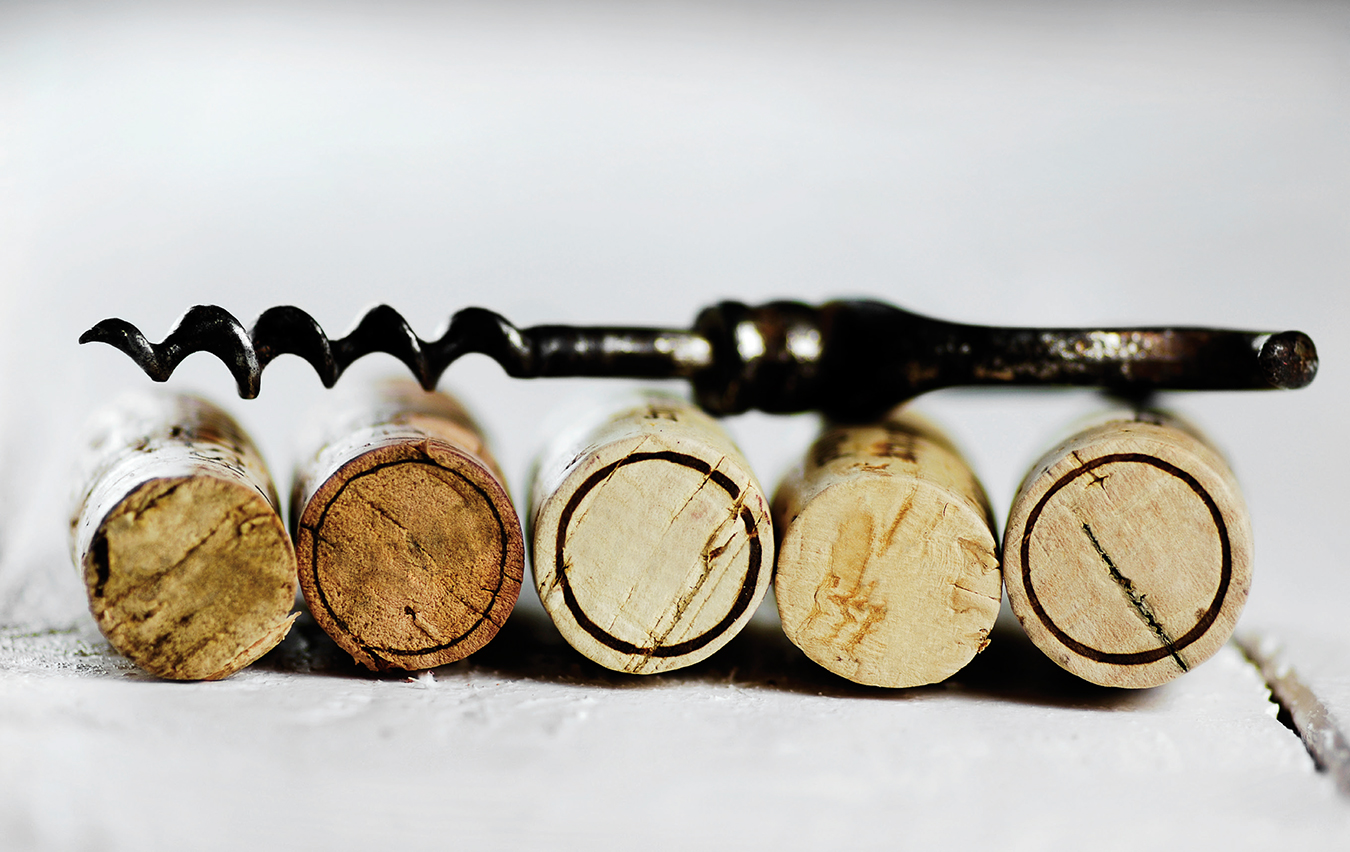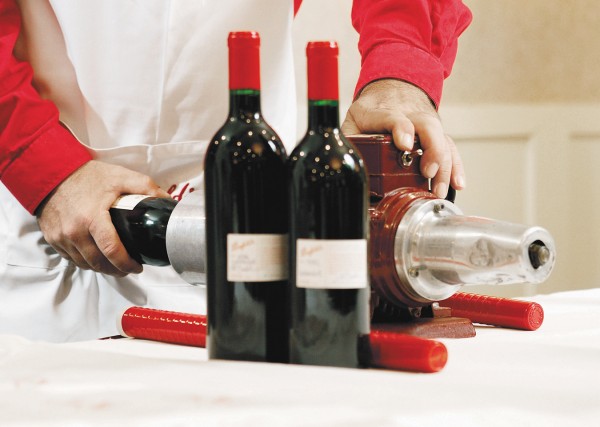Preserving Wine
The practice of recorking.

Diamonds are forever, but corks are for 25 years. Well, sort of. In reality, of course, there’s no certainty about the longevity of a cork when it’s used for sealing a wine bottle; there are no actuarial tables for corks, and how long they last depends on variables like the quality of the cork and the conditions in which the bottle of wine is kept. But there is a limit to the time a cork can successfully prevent air from getting at wine and spoiling it, because over time the wine seeps into the cork and the cork eventually disintegrates. The best-quality corks might last a lot longer than 25 years when they’re in bottles cellared in optimum conditions (between 12ºC and 14ºC, with 50 to 80 per cent relative humidity) and stored on their side, so that constant contact with wine prevents the cork from drying and shrinking.
The question of cork longevity is important for anyone who cellars wine over the medium or long term. Although it’s true that the vast bulk of the world’s wine is made for quite early drinking—most within three or four years of the vintage—there are millions of bottles of vins de garde, wines that are to be cellared for 10, 20, and more years before they reach their optimum drinking condition. They include many famous wines from Bordeaux and Burgundy, great cabernets from California and Italy, and shirazes from Australia. Many are too tannic and too unbalanced in youth, and need years of aging before they’re ready to drink.
No matter whether a cellar is chock full or holds only a handful of these wines, the cork is often the weak point in successful long-term conservation. It can fail well before the wine has reached its optimum age, and because the cork is what protects the wine from oxygen, it’s what often determines whether the bottle holds a gracefully aged wine, or one that’s oxidized and dead.
With this in mind, many wineries that keep libraries of wines from vintages that date back decades recork the bottles about every quarter-century. It’s a delicate procedure, because as soon as the cork is removed from a bottle, oxygen starts to attack the wine. The trick, then, is to remove the old cork and insert the new one as quickly as possible. Older wine is much more susceptible than younger wine to rapid oxidation, which is why old wines are generally opened just before they’re to be drunk, and are seldom decanted. Inert gas is sometimes pumped into the bottle to provide a layer of protection during the recorking process, especially if the wine will be checked for quality while it’s uncorked.
Only one major wine company provides a recorking service around the world: Penfolds Wines, which offers recorking clinics for any Penfolds wine that’s at least 15 years old.
Some producers may recork older vintages of their wines if they are brought to the winery. They often refer to it as “reconditioning”, although that term suggests a broader process affecting the wine itself than simply replacing a deteriorating cork. But only one major wine company provides a recorking service around the world: Penfolds Wines of South Australia, which regularly offers recorking clinics for any Penfolds wine that’s at least 15 years old. These clinics have been held in such diverse locations as Melbourne, Moscow, Stockholm, and London, cities that have a critical mass of people owning older vintages of Penfolds wines.
More than 100,000 bottles of Penfolds wines have been recorked at these clinics since they began 20 years ago. The oldest bottle recorked (at a clinic in Brisbane, Australia) was a 1903 half-bottle of St. Henri Shiraz. The oldest wines brought for recorking at a recent Toronto clinic in 2010 were from the 1960s and 1970s.
The clinics do more than simply replace one cork with another. Each wine is assessed visually by a Penfolds winemaker—chief winemaker Peter Gago and red winemaker Steve Lienert participated in the recent Toronto clinic—to see if the level of the wine has dropped significantly. If it has, the wine is opened, a small sample is poured, and argon gas is pumped into the bottle to protect the wine while it’s open. The sample is then tasted by a winemaker and the owner of the wine. Bottles can be recorked whether the wine is in good condition or not—it is entirely at the discretion of the collector—but wine judged to be in poor condition is not given a seal of approval. Gago says that the wine must meet a certain threshold. “It needn’t be the best example of its vintage, but it must be acceptable,” he says. Before the wine is recorked, the wine removed for tasting is replaced with the latest vintage of the same wine—for example, a bottle of 1990 Penfolds Grange would be topped up with a little of the 2005 Grange—before a new Penfolds cork is inserted, a red Penfolds capsule is put on, and the bottle is certified with a seal. Each seal is signed by the winemaker and carries a number that is recorded in a database. This enables anyone thinking of buying a recorked wine to check with Penfolds to verify that the bottle had been checked and resealed by a Penfolds winemaker.
This security feature responds to concern in the wine world that reconditioning bottles was facilitating wine fraud. Counterfeit wine is a widespread problem—there are estimates that as much as five per cent of fine wine on the secondary market is fake—and there’s some concern that the practice of recorking can indirectly give legitimacy and provenance to wines that are not what they appear to be. Although it’s not so hard for wine counterfeiters to come up with a bottle that looks like the original and to forge a reasonable facsimile of the label, it’s much more difficult to produce a cork that looks the right age and a capsule that is almost always printed or embossed with the name of the producer. But the practice of recorking enables criminals to explain a new cork and generic capsule away by claiming that the wine in question has been reconditioned. It’s the reason many wine professionals, including Serena Sutcliffe of Sotheby’s auction house in London, oppose recorking.

The final step of a Penfolds recorking clinic involves putting a signature red Penfolds capsule on the bottle.
There are also objections to topping up recorked wine with wine from a different vintage. Gago counters this by pointing out that the 15 millilitres of added wine represents less than two per cent of the bottle, and that it is “below the threshold, so no one can detect the difference.” (In fact, most wine laws allow producers to blend a small percentage of wine from a different vintage and to label the wine with the vintage that represents most of it.)
Although Penfolds’s service responds to the real problem of aging wine over the long term, Gago readily acknowledges that many corks last much longer than the 15 years, which is the minimum age at which he replaces them in his clinics. In 2009, an owner brought a bottle of 1955 Grange (Penfolds’s top wine) in for recorking. The visual appraisal wasn’t promising (the level was down), but Gago says, “When I tasted it, it was one of the best ’55s I’ve ever tasted.” The original cork had successfully protected the wine for nearly 55 years.
Another well-known Australian winemaker, Peter Lehmann, demonstrated the potential longevity of corks at a recent Toronto tasting that included red wines from the 1958, 1963, and 1973 vintages. Each of these wines were from Lehmann’s personal cellar, and although none had been recorked, none were oxidized, even though some of the corks were in very poor shape. The wine from the 1958 vintage, Saltram Bin 20 Claret (which was 85 per cent shiraz, with support from dolcetto and muscadelle), was vibrant when it was opened, but it began to degrade and oxidize about 90 minutes later. Clearly, the cork had done its job well for more than 60 years. As for the 1973 Saltram HP Basket Press Shiraz, the cork had held up so well for nearly 40 years that Lehmann pronounced the wine to be “still only a baby.”
But leaving the original cork in a bottle that long, or even 30 or 40 years, is a gamble, especially when older vintages of sought-after wines are worth tens of thousands of dollars. Gago stresses that recorking an old bottle doesn’t give it any extra life; rather, it “arrests further deterioration” caused by a cork that isn’t providing the sort of seal it should. Despite the help that recorking can give to counterfeiters, the process can be a great boon to collectors who want to hold on to their wines for decades, and yet minimize the risks of having it spoil because the cork deteriorated and exposed the wine to air.
Top photo ©Ina Peters/iStockPhoto.




